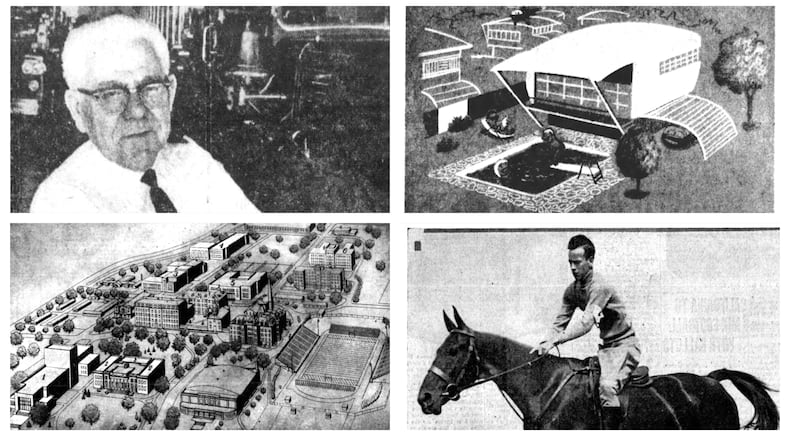Here’s a look at some stories from the week of Sept. 22-28.
Sept. 25, 1932: Equine aristocrats of Miami Valley in brilliant review at annual horse show
Action, thrills and the innumerable fine points of horse training and performance were presented for Daytonians and visitors at the annual Dayton Country Club horse show.
Before its largest audience, the horse show stepped off in brilliant fashion at the Miami Valley Hunt and Polo Club.
Ringmaster A.L. Jones, with the help of G.B. McClelland at the microphone, covered 22 events in rapid succession with a few brief interludes of band music.
One highlight was the scene of Red Bird, ridden by Lucille Aumann, jumping through a ring of fire. Red Bird also dazzled the crowd by dancing a waltz to music and perfectly following many commands.
There were also military exercises and steeplechase jumps to go along with the standard horse showings.
It was reported that proceeds from the show resulted in more than $2,000 to be donated to the Girl Scouts.
Sept. 27, 1942: Dayton asked to go all-out in scrap drive
It was time for Dayton and Montgomery County to face a few hard facts.
The city and its citizens had fallen short of goals in the national campaign to collect scrap metal for the war effort.
Nebraska was given as an example where 100 pounds of scrap was collected for every man. Ohio hadn’t reached even a third of that result.
Steel mills in the U.S. were down to less than a 30-day supply of scrap metal available. Since steel cannot be made without scrap, that meant that unless thousands of tones of additional scrap were collected quickly, our steel mills would have to slow production sharply.
Montgomery County’s newly launched campaign called for a quota of 50 pounds per person, or a total of 7,500 tons of scrap metal.
The message was that all useless iron fences had to come down and obsolete boilers, heaters, water tanks, Civil and World War I cannons, public statues and memorials would all be needed.
Officials said that “the luxury of sentimentality over inanimate objects no longer can be afforded.”
Sept. 28, 1952: University of Dayton to revamp with $6 million program
In 1952, the University of Dayton announced a development program estimated to cost $6.3 million over the next 12 years.
The construction phase of the development program included a new science building, chemistry and chemical engineering building, an auditorium, music and speech building , and a college union.
It also included a dormitory to accommodate 432 students, and library additions, which were previously announced.
All buildings were to be constructed on land already owned by the university.
The additions were to supply space for an anticipated enrollment of 3,000 students.
Sept. 23, 1962: Dayton residents make predictions for Dayton in the year 2000
At the time of this article, the year 2000 was a little over 37 years away.
The Dayton Daily News decided to ask readers what they thought Dayton would be like at the start of the 21st century.
“If you look back 40 years, you’ll see some dramatic changes in Dayton, and in the next 40 the changes will be even more dramatic,” said Robert Flynn, city planning director.
Flynn went on to predict the city center population would double in the next 30 years, instead of declining, as it had over the previous decade.
Underground parking areas, monorails and the increased use of helicopters as a mode of travel were also predicted by Flynn.
Kathryn O’Keeffe, technical editor of the Monsanto Research Corp., had an interesting vision.
“I can visualize having some magnificent apartments down by the river for people who live in the city,” she said.
Businesses, predicted James Clarke of the Dayton Chamber of Commerce, would enjoy overnight delivery to and from everywhere in the world.
Most homes, he added, would be air conditioned. Such a large percentage of foods would be in frozen form many would be constructing homes with built-in freezers.
Sept. 24, 1972: Aging firefighter still full of sparks
The little boy who once had the big dream of becoming a fireman was now hobbling back and forth on a pair of crutches to his shiny red fire chief’s car.
“I can truly say I became as an adult what I wished to be as a child,” said 70-year-old Walter Buffington.
Buffington was asked to leave his 46-year career at the Xenia Fire Department a few months prior, after reaching the mandatory retirement age of 70.
The Xenia city manager found his replacement was harder to find than expected, and Buffington was still on the job until that replacement could be found.
Buffington was recovering from a broken ankle, suffered while stepping through a floor board while doing a house inspection. He bragged that didn’t miss a day of work because of it though.
Buffington had been the fire chief since 1950, and immediately began efforts to enforce building codes in the city.
“There were just too many fires occurring because dangerous hazards existed within the structure of buildings,” he said.
On the city of Xenia, Buffington said, “I know one third of the people here by name, another third by sight and the remaining one third are friends of mine that I’ve never met.”
About the Author






